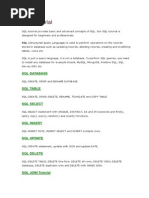Python - Pandas Merging, Joining, and Concatenating
Uploaded by
Ashner NovillaPython - Pandas Merging, Joining, and Concatenating
Uploaded by
Ashner NovillaPython | Pandas Merging, Joining, and Concatenating
Pandas DataFrame is two-dimensional size-mutable, potentially heterogeneous tabular data structure with labelled axes (rows and columns). A
Data frame is a two-dimensional data structure, i.e., data is aligned in a tabular fashion in rows and columns. We can join, merge, and concat
dataframe using different methods. In Dataframe df.merge(),df.join(), and df.concat() methods help in joining, merging and concating different dataframe.
In order to concat dataframe, we use concat() function which helps in concatenating a dataframe. We can concat a dataframe in many different ways,
they are:
Concatenating DataFrame using .concat()
Concatenating DataFrame by setting logic on axes
Concatenating DataFrame using .append()
Concatenating DataFrame by ignoring indexes
Concatenating DataFrame with group keys
Concatenating with mixed ndims
Concatenating DataFrame using .concat() :
In order to concat a dataframe, we use .concat() function this function concat a dataframe and returns a new dataframe.
# importing pandas module
import pandas as pd
# Define a dictionary containing employee data
data1 = {'Name':['Jai', 'Princi', 'Gaurav', 'Anuj'],
'Age':[27, 24, 22, 32],
'Address':['Nagpur', 'Kanpur', 'Allahabad', 'Kannuaj'],
'Qualification':['Msc', 'MA', 'MCA', 'Phd']}
# Define a dictionary containing employee data
data2 = {'Name':['Abhi', 'Ayushi', 'Dhiraj', 'Hitesh'],
'Age':[17, 14, 12, 52],
'Address':['Nagpur', 'Kanpur', 'Allahabad', 'Kannuaj'],
'Qualification':['Btech', 'B.A', 'Bcom', 'B.hons']}
# Convert the dictionary into DataFrame
df = pd.DataFrame(data1,index=[0, 1, 2, 3])
# Convert the dictionary into DataFrame
df1 = pd.DataFrame(data2, index=[4, 5, 6, 7])
print(df, "\n\n", df1)
Now we apply .concat function in order to concat two dataframe
AD
# using a .concat() method
frames = [df, df1]
res1 = pd.concat(frames)
res1
Output :
As shown in the output image, we have created two dataframe after concatenating we get one dataframe
Concatenating DataFrame by setting logic on axes :
In order to concat dataframe, we have to set different logic on axes. We can set axes in the following three ways:
Taking the union of them all, join='outer'. This is the default option as it results in zero information loss.
Taking the intersection, join='inner'.
Use a speci c index, as passed to the join_axes argument
# importing pandas module
import pandas as pd
# Define a dictionary containing employee data
data1 = {'Name':['Jai', 'Princi', 'Gaurav', 'Anuj'],
'Age':[27, 24, 22, 32],
'Address':['Nagpur', 'Kanpur', 'Allahabad', 'Kannuaj'],
'Qualification':['Msc', 'MA', 'MCA', 'Phd'],
'Mobile No': [97, 91, 58, 76]}
# Define a dictionary containing employee data
data2 = {'Name':['Gaurav', 'Anuj', 'Dhiraj', 'Hitesh'],
'Age':[22, 32, 12, 52],
'Address':['Allahabad', 'Kannuaj', 'Allahabad', 'Kannuaj'],
'Qualification':['MCA', 'Phd', 'Bcom', 'B.hons'],
'Salary':[1000, 2000, 3000, 4000]}
# Convert the dictionary into DataFrame
df = pd.DataFrame(data1,index=[0, 1, 2, 3])
# Convert the dictionary into DataFrame
df1 = pd.DataFrame(data2, index=[2, 3, 6, 7])
print(df, "\n\n", df1)
Now we set axes join = inner for intersection of dataframe
# applying concat with axes
# join = 'inner'
res2 = pd.concat([df, df1], axis=1, join='inner')
res2
Output :
As shown in the output image, we get the intersection of dataframe
Now we set axes join = outer for union of dataframe.
# using a .concat for
# union of dataframe
res2 = pd.concat([df, df1], axis=1, sort=False)
res2
Output :
As shown in the output image, we get the union of dataframe
Now we used a specific index, as passed to the join_axes argument
# using join_axes
res3 = pd.concat([df, df1], axis=1, join_axes=[df.index])
res3
Output :
Concatenating DataFrame using .append()
In order to concat a dataframe, we use .append() function this function concatenate along axis=0, namely the index. This function exist before .concat.
# importing pandas module
import pandas as pd
# Define a dictionary containing employee data
data1 = {'Name':['Jai', 'Princi', 'Gaurav', 'Anuj'],
'Age':[27, 24, 22, 32],
'Address':['Nagpur', 'Kanpur', 'Allahabad', 'Kannuaj'],
'Qualification':['Msc', 'MA', 'MCA', 'Phd']}
# Define a dictionary containing employee data
data2 = {'Name':['Abhi', 'Ayushi', 'Dhiraj', 'Hitesh'],
'Age':[17, 14, 12, 52],
'Address':['Nagpur', 'Kanpur', 'Allahabad', 'Kannuaj'],
'Qualification':['Btech', 'B.A', 'Bcom', 'B.hons']}
# Convert the dictionary into DataFrame
df = pd.DataFrame(data1,index=[0, 1, 2, 3])
# Convert the dictionary into DataFrame
df1 = pd.DataFrame(data2, index=[4, 5, 6, 7])
print(df, "\n\n", df1)
Now we apply .append() function inorder to concat to dataframe
# using append function
res = df.append(df1)
res
Output :
Concatenating DataFrame by ignoring indexes :
In order to concat a dataframe by ignoring indexes, we ignore index which don’t have a meaningful meaning, you may wish to append them and
ignore the fact that they
may have overlapping indexes. In order to do that we use ignore_index as an argument.
# importing pandas module
import pandas as pd
# Define a dictionary containing employee data
data1 = {'Name':['Jai', 'Princi', 'Gaurav', 'Anuj'],
'Age':[27, 24, 22, 32],
'Address':['Nagpur', 'Kanpur', 'Allahabad', 'Kannuaj'],
'Qualification':['Msc', 'MA', 'MCA', 'Phd'],
'Mobile No': [97, 91, 58, 76]}
# Define a dictionary containing employee data
data2 = {'Name':['Gaurav', 'Anuj', 'Dhiraj', 'Hitesh'],
'Age':[22, 32, 12, 52],
'Address':['Allahabad', 'Kannuaj', 'Allahabad', 'Kannuaj'],
'Qualification':['MCA', 'Phd', 'Bcom', 'B.hons'],
'Salary':[1000, 2000, 3000, 4000]}
# Convert the dictionary into DataFrame
df = pd.DataFrame(data1,index=[0, 1, 2, 3])
# Convert the dictionary into DataFrame
df1 = pd.DataFrame(data2, index=[2, 3, 6, 7])
print(df, "\n\n", df1)
Now we are going to apply ignore_index as an argument.
# using ignore_index
res = pd.concat([df, df1], ignore_index=True)
res
Output :
Concatenating DataFrame with group keys :
In order to concat dataframe with group keys, we override the column names with the use of the keys argument. Keys argument is to override the
column names when creating a new DataFrame based on existing Series.
# importing pandas module
import pandas as pd
# Define a dictionary containing employee data
data1 = {'Name':['Jai', 'Princi', 'Gaurav', 'Anuj'],
'Age':[27, 24, 22, 32],
'Address':['Nagpur', 'Kanpur', 'Allahabad', 'Kannuaj'],
'Qualification':['Msc', 'MA', 'MCA', 'Phd']}
# Define a dictionary containing employee data
data2 = {'Name':['Abhi', 'Ayushi', 'Dhiraj', 'Hitesh'],
'Age':[17, 14, 12, 52],
'Address':['Nagpur', 'Kanpur', 'Allahabad', 'Kannuaj'],
'Qualification':['Btech', 'B.A', 'Bcom', 'B.hons']}
# Convert the dictionary into DataFrame
df = pd.DataFrame(data1,index=[0, 1, 2, 3])
# Convert the dictionary into DataFrame
df1 = pd.DataFrame(data2, index=[4, 5, 6, 7])
print(df, "\n\n", df1)
Now we use keys as an argument.
# using keys
frames = [df, df1 ]
res = pd.concat(frames, keys=['x', 'y'])
res
Output :
Concatenating with mixed ndims :
User can concatenate a mix of Series and DataFrame. The Series will be transformed to DataFrame with the column name as the name of the Series.
# importing pandas module
import pandas as pd
# Define a dictionary containing employee data
data1 = {'Name':['Jai', 'Princi', 'Gaurav', 'Anuj'],
'Age':[27, 24, 22, 32],
'Address':['Nagpur', 'Kanpur', 'Allahabad', 'Kannuaj'],
'Qualification':['Msc', 'MA', 'MCA', 'Phd']}
# Convert the dictionary into DataFrame
df = pd.DataFrame(data1,index=[0, 1, 2, 3])
# creating a series
s1 = pd.Series([1000, 2000, 3000, 4000], name='Salary')
print(df, "\n\n", s1)
Now we are going to mix Series and dataframe together
# combining series and dataframe
res = pd.concat([df, s1], axis=1)
res
Output :
Merging DataFrame
Pandas have options for high-performance in-memory merging and joining. When we need to combine very large DataFrames, joins serve as a
powerful way to perform these operations swiftly. Joins can only be done on two DataFrames at a time, denoted as left and right tables. The key is
the common column that the two DataFrames will be joined on. It’s a good practice to use keys which have unique values throughout the column to
avoid unintended duplication of row values. Pandas provide a single function, merge(), as the entry point for all standard database join operations
between DataFrame objects.
There are four basic ways to handle the join (inner, left, right, and outer), depending on which rows must retain their data.
Code #1 : Merging a dataframe with one unique key combination
# importing pandas module
import pandas as pd
# Define a dictionary containing employee data
data1 = {'key': ['K0', 'K1', 'K2', 'K3'],
'Name':['Jai', 'Princi', 'Gaurav', 'Anuj'],
'Age':[27, 24, 22, 32],}
# Define a dictionary containing employee data
data2 = {'key': ['K0', 'K1', 'K2', 'K3'],
'Address':['Nagpur', 'Kanpur', 'Allahabad', 'Kannuaj'],
'Qualification':['Btech', 'B.A', 'Bcom', 'B.hons']}
# Convert the dictionary into DataFrame
df = pd.DataFrame(data1)
# Convert the dictionary into DataFrame
df1 = pd.DataFrame(data2)
print(df, "\n\n", df1)
Now we are using .merge() with one unique key combination
# using .merge() function
res = pd.merge(df, df1, on='key')
res
Output :
Code #2: Merging dataframe using multiple join keys.
# importing pandas module
import pandas as pd
# Define a dictionary containing employee data
data1 = {'key': ['K0', 'K1', 'K2', 'K3'],
'key1': ['K0', 'K1', 'K0', 'K1'],
'Name':['Jai', 'Princi', 'Gaurav', 'Anuj'],
'Age':[27, 24, 22, 32],}
# Define a dictionary containing employee data
data2 = {'key': ['K0', 'K1', 'K2', 'K3'],
'key1': ['K0', 'K0', 'K0', 'K0'],
'Address':['Nagpur', 'Kanpur', 'Allahabad', 'Kannuaj'],
'Qualification':['Btech', 'B.A', 'Bcom', 'B.hons']}
# Convert the dictionary into DataFrame
df = pd.DataFrame(data1)
# Convert the dictionary into DataFrame
df1 = pd.DataFrame(data2)
print(df, "\n\n", df1)
Now we merge dataframe using multiple keys
# merging dataframe using multiple keys
res1 = pd.merge(df, df1, on=['key', 'key1'])
res1
Output :
Merging dataframe using how in an argument:
We use how argument to merge specifies how to determine which keys are to be included in the resulting table. If a key combination does not
appear in either the left or right tables, the values in the joined table will be NA. Here is a summary of the how options and their SQL equivalent
names:
MERGE METHOD JOIN NAME DESCRIPTION
left LEFT OUTER JOIN Use keys from left frame only
right RIGHT OUTER JOIN Use keys from right frame only
outer FULL OUTER JOIN Use union of keys from both frames
inner INNER JOIN Use intersection of keys from both frames
# importing pandas module
import pandas as pd
# Define a dictionary containing employee data
data1 = {'key': ['K0', 'K1', 'K2', 'K3'],
'key1': ['K0', 'K1', 'K0', 'K1'],
'Name':['Jai', 'Princi', 'Gaurav', 'Anuj'],
'Age':[27, 24, 22, 32],}
# Define a dictionary containing employee data
data2 = {'key': ['K0', 'K1', 'K2', 'K3'],
'key1': ['K0', 'K0', 'K0', 'K0'],
'Address':['Nagpur', 'Kanpur', 'Allahabad', 'Kannuaj'],
'Qualification':['Btech', 'B.A', 'Bcom', 'B.hons']}
# Convert the dictionary into DataFrame
df = pd.DataFrame(data1)
# Convert the dictionary into DataFrame
df1 = pd.DataFrame(data2)
print(df, "\n\n", df1)
Now we set how = 'left' in order to use keys from left frame only.
# using keys from left frame
res = pd.merge(df, df1, how='left', on=['key', 'key1'])
res
Output :
Now we set how = 'right' in order to use keys from right frame only.
# using keys from right frame
res1 = pd.merge(df, df1, how='right', on=['key', 'key1'])
res1
Output :
Now we set how = 'outer' in order to get union of keys from dataframes.
# getting union of keys
res2 = pd.merge(df, df1, how='outer', on=['key', 'key1'])
res2
Output :
Now we set how = 'inner' in order to get intersection of keys from dataframes.
# getting intersection of keys
res3 = pd.merge(df, df1, how='inner', on=['key', 'key1'])
res3
Output :
Joining DataFrame
In order to join dataframe, we use .join() function this function is used for combining the columns of two potentially differently-indexed DataFrames
into a single result DataFrame.
# importing pandas module
import pandas as pd
# Define a dictionary containing employee data
data1 = {'Name':['Jai', 'Princi', 'Gaurav', 'Anuj'],
'Age':[27, 24, 22, 32]}
# Define a dictionary containing employee data
data2 = {'Address':['Allahabad', 'Kannuaj', 'Allahabad', 'Kannuaj'],
'Qualification':['MCA', 'Phd', 'Bcom', 'B.hons']}
# Convert the dictionary into DataFrame
df = pd.DataFrame(data1,index=['K0', 'K1', 'K2', 'K3'])
# Convert the dictionary into DataFrame
df1 = pd.DataFrame(data2, index=['K0', 'K2', 'K3', 'K4'])
print(df, "\n\n", df1)
Now we are use .join() method in order to join dataframes
# joining dataframe
res = df.join(df1)
res
Output :
Now we use how = 'outer' in order to get union
# getting union
res1 = df.join(df1, how='outer')
res1
Output :
Joining dataframe using on in an argument :
In order to join dataframes we use on in an argument. join() takes an optional on argument which may be a column or multiple column names, which
specifies that the passed DataFrame is to be aligned on that column in the DataFrame.
# importing pandas module
import pandas as pd
# Define a dictionary containing employee data
data1 = {'Name':['Jai', 'Princi', 'Gaurav', 'Anuj'],
'Age':[27, 24, 22, 32],
'Key':['K0', 'K1', 'K2', 'K3']}
# Define a dictionary containing employee data
data2 = {'Address':['Allahabad', 'Kannuaj', 'Allahabad', 'Kannuaj'],
'Qualification':['MCA', 'Phd', 'Bcom', 'B.hons']}
# Convert the dictionary into DataFrame
df = pd.DataFrame(data1)
# Convert the dictionary into DataFrame
df1 = pd.DataFrame(data2, index=['K0', 'K2', 'K3', 'K4'])
print(df, "\n\n", df1)
Now we are using .join with “on” argument
# using on argument in join
res2 = df.join(df1, on='Key')
res2
Output :
Joining singly-indexed DataFrame with multi-indexed DataFrame :
In order to join singly indexed dataframe with multi-indexed dataframe, the level will match on the name of the index of the singly-indexed frame
against a level name of the multi-indexed frame.
# importing pandas module
import pandas as pd
# Define a dictionary containing employee data
data1 = {'Name':['Jai', 'Princi', 'Gaurav'],
'Age':[27, 24, 22]}
# Define a dictionary containing employee data
data2 = {'Address':['Allahabad', 'Kannuaj', 'Allahabad', 'Kanpur'],
'Qualification':['MCA', 'Phd', 'Bcom', 'B.hons']}
# Convert the dictionary into DataFrame
df = pd.DataFrame(data1, index=pd.Index(['K0', 'K1', 'K2'], name='key'))
index = pd.MultiIndex.from_tuples([('K0', 'Y0'), ('K1', 'Y1'),
('K2', 'Y2'), ('K2', 'Y3')],
names=['key', 'Y'])
# Convert the dictionary into DataFrame
df1 = pd.DataFrame(data2, index= index)
print(df, "\n\n", df1)
Now we join singly indexed dataframe with multi-indexed dataframe
# joining singly indexed with
# multi indexed
result = df.join(df1, how='inner')
result
Output :
You might also like
- Merge, Join, and Concatenate: Concatenating ObjectsNo ratings yetMerge, Join, and Concatenate: Concatenating Objects62 pages
- Pandas+With+Python+ +DATAhill+SolutionsNo ratings yetPandas+With+Python+ +DATAhill+Solutions24 pages
- What Can You Do With Dataframes Using Pandas?: Pandas Is A High-Level Data Manipulation Tool Developed by Wes MckinneyNo ratings yetWhat Can You Do With Dataframes Using Pandas?: Pandas Is A High-Level Data Manipulation Tool Developed by Wes Mckinney10 pages
- Lecture 8 - Data Wrangling Using PandasNo ratings yetLecture 8 - Data Wrangling Using Pandas31 pages
- Pandas_Dataframe_All_Operations_1735471870No ratings yetPandas_Dataframe_All_Operations_17354718704 pages
- Chapter 2 Data Handling using pandas - I(DATA FRAME)No ratings yetChapter 2 Data Handling using pandas - I(DATA FRAME)15 pages
- Data Science Data Manipulation With PandasNo ratings yetData Science Data Manipulation With Pandas77 pages
- Introduction To Pandas in Data AnalyticsNo ratings yetIntroduction To Pandas in Data Analytics12 pages
- Block 1-Data Handling Using Pandas DataFrameNo ratings yetBlock 1-Data Handling Using Pandas DataFrame17 pages
- Mod3 Supplychainanalytics Usecases Part 1No ratings yetMod3 Supplychainanalytics Usecases Part 127 pages
- Confusion Matrix, Accuracy, Precision, Recall, F1 ScoreNo ratings yetConfusion Matrix, Accuracy, Precision, Recall, F1 Score1 page
- Certified Data Scientist: Program BrochureNo ratings yetCertified Data Scientist: Program Brochure14 pages
- V R R R V V: Questions and Problems 1. R R +R R 300 + 600 R 900No ratings yetV R R R V V: Questions and Problems 1. R R +R R 300 + 600 R 9003 pages
- Problem No. 4.32: Implement the following Boolean function with a multiplexer. (a) F (A,B,C,D) = ∑ (0, 2, 5, 7, 11, 14) (b) F (A,B,C,D) = π (3, 8, 12) Answer by: Elbambo, Roberto Jerome S. Solution100% (3)Problem No. 4.32: Implement the following Boolean function with a multiplexer. (a) F (A,B,C,D) = ∑ (0, 2, 5, 7, 11, 14) (b) F (A,B,C,D) = π (3, 8, 12) Answer by: Elbambo, Roberto Jerome S. Solution4 pages
- Terminal Test Document Plan (Revised As of 23january2019)No ratings yetTerminal Test Document Plan (Revised As of 23january2019)134 pages
- Computer Systems (LCST) Nov2012 - Part 08No ratings yetComputer Systems (LCST) Nov2012 - Part 084 pages
- Free PPT Templates: Insert The Subtitle of Your PresentationNo ratings yetFree PPT Templates: Insert The Subtitle of Your Presentation48 pages
- Cloud Computing On Blue PowerPoint Templates WidescreenNo ratings yetCloud Computing On Blue PowerPoint Templates Widescreen3 pages
- IMS506 Chapt 8 9780538469685 - PPT - ch07No ratings yetIMS506 Chapt 8 9780538469685 - PPT - ch0751 pages
- Implementation of Different Types of JoinsNo ratings yetImplementation of Different Types of Joins9 pages
- "Weekly 11-19 Only HND Ko Kasama Exam I-Feedback Niyo Ko para Masend Ko Thru Sa Inyo " Happy Answering!No ratings yet"Weekly 11-19 Only HND Ko Kasama Exam I-Feedback Niyo Ko para Masend Ko Thru Sa Inyo " Happy Answering!12 pages
- SQL Server Interview Questions and Answers PDFNo ratings yetSQL Server Interview Questions and Answers PDF22 pages
- Previous Year Oracle Solved Aptitude Question PapersNo ratings yetPrevious Year Oracle Solved Aptitude Question Papers10 pages
- Semester 3 IT and E-Learning Skills (ICT151) : Microcomm InfotechNo ratings yetSemester 3 IT and E-Learning Skills (ICT151) : Microcomm Infotech16 pages
- Comparative Analysis of Join Types Join: ID NameNo ratings yetComparative Analysis of Join Types Join: ID Name8 pages
- Database Programming With SQL Mid Semester 1No ratings yetDatabase Programming With SQL Mid Semester 154 pages














































































































